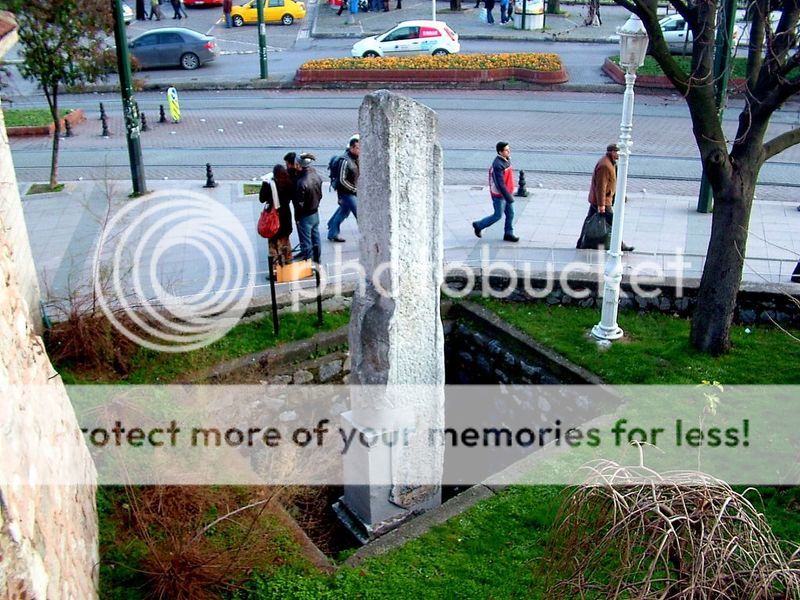GPS : 41°00'28.9"N 28°58'41.0"E / 41.008028, 28.978056

PHOTOGRAPHS ALBUM
In 20 BC Emperor Augustus erected a column in Foro Romano; it was called Miliarium Aureum because it served as the starting point for measuring the length of the roads leading to the main towns of the empire (it is now lost). In Constantinople this function was assigned to an arch (Milion) which was located at the northern end of the Hippodrome; recent excavations have brought to light a long stone which is thought to have been part of that arch.
Its purpose was the same as the Milion Stone of Rome in Italy. It marked the very point where distances of the major cities of the empire from Constantinople was calculated by and it’s base featured inscriptions showing some of those distances. At the time of Byzantine empire, the city was referred as The New Rome, and the saying “every road leads to Rome” meant Constantinope in the Eastern Roman Empire and too the Milion Stone in the Hippodrome.
Today, remains of the Milion Stone is located near the water tower in Sultanahmet (towards the Basilica Cistern). The Milion was a monument in Constantinople. It was the origin and start of measurement of distances for all the roads leading to the cities of the Byzantine Empire, and had the same function which the Milliarium Aureum of Rome still has today.
The remains of the monument are located in Istanbul, in the district of Fatih, in the neighborhood of Cağaloğlu, at the northern corner of the square of Hagia Sophia, and close to the Basilica Cistern.
When Emperor Constantine rebuilt the city of Byzantium to make it his new imperial capital, which he named New Rome, he consciously emulated many of the features of Elder Rome. Among these was the Milion: it was a Tetrapylon surmounted by a dome, built in the first Region of the city, near the old Walls of Byzantium, at the very beginning of the main thoroughfare of the new city, the Mese, which at that point formed a bend.
The new building fulfilled the same role as the Milliarium Aureum in Rome: it was considered as the origin of all the roads leading to the European cities of the Byzantine Empire, and on its base were inscribed the distances of all the main cities of the Empire from Constantinople. The monument bordered to the East the Augustaeum, and was much more complex than its Roman counterpart.
It can be described as a double Triumphal Arch surmounted by a dome, which was carried by four arches. It was crowned by the statues of Constantine and his mother Helena with a cross looking towards east between them. A statue of the Tyche of the City stood behind them.
From the beginning of the sixth century, the building became an increasingly important station of the imperial ceremonial. Justinian I added to it a Sundial, while Justin II adorned the lower part with the statues of his wife Sophia, his daughter Arabia and his niece Helena. The monument was also adorned with equestrian sculptures of Trajan, Hadrian, Theodosius II and a bronze Quadriga of Helios.
During the first half of the eighth century, the vaults of the building were adorned by Emperors Philippikos and Anastasios II with paintings of past ecumenical councils, but during the Iconoclastic Age Emperor Constantine V replaced them with scenes from the Hippodrome.
During the Comnenian Age the Milion, due to its strategic position, witnessed fights in the city, like those between Nikephoros III and Alexios I, or those between imperial troops and Empress Maria of Antioch, who from this position was controlling the Augustaeum. In 1268/71, after the end of the Latin Empire, the Milion, together with the Augustaeum, became property of the church of Hagia Sophia.
After the Ottoman conquest of Constantinople, the building remained intact up to the end of the fifteenth century. It disappeared possibly at the beginning of sixteenth century because of the enlargement of the Aqueduct and the subsequent erection of the nearby Suterazisi (Turkish: "Water tower", lit. "water scale").
In the years 1967/68, following theoretical studies about the location of the monument and after the demolition of the houses placed above it, excavations revealed some foundations and a pillar (now put up again) belonging to the building. These remains could be positively identified as belonging to the Milion thanks to their vicinity to a part of bent Byzantine canalization. This seems to indicate the angle of the disappeared Mese as reported by the literary sources.
LOCATION SATELLITE MAP
These scripts and photographs are registered under © Copyright 2016, respected writers and photographers from the internet. All Rights Reserved.
No comments:
Post a Comment